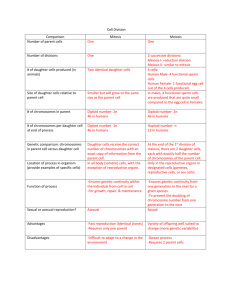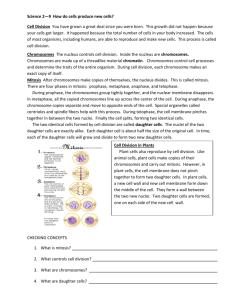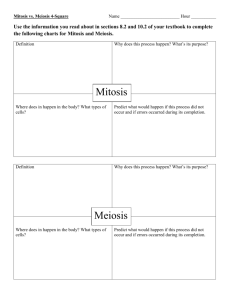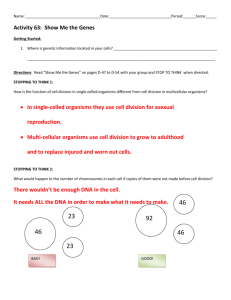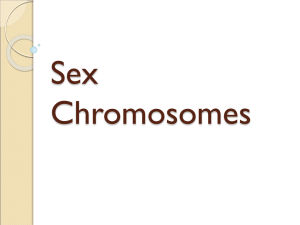Teacher Pre Lab Guide
advertisement
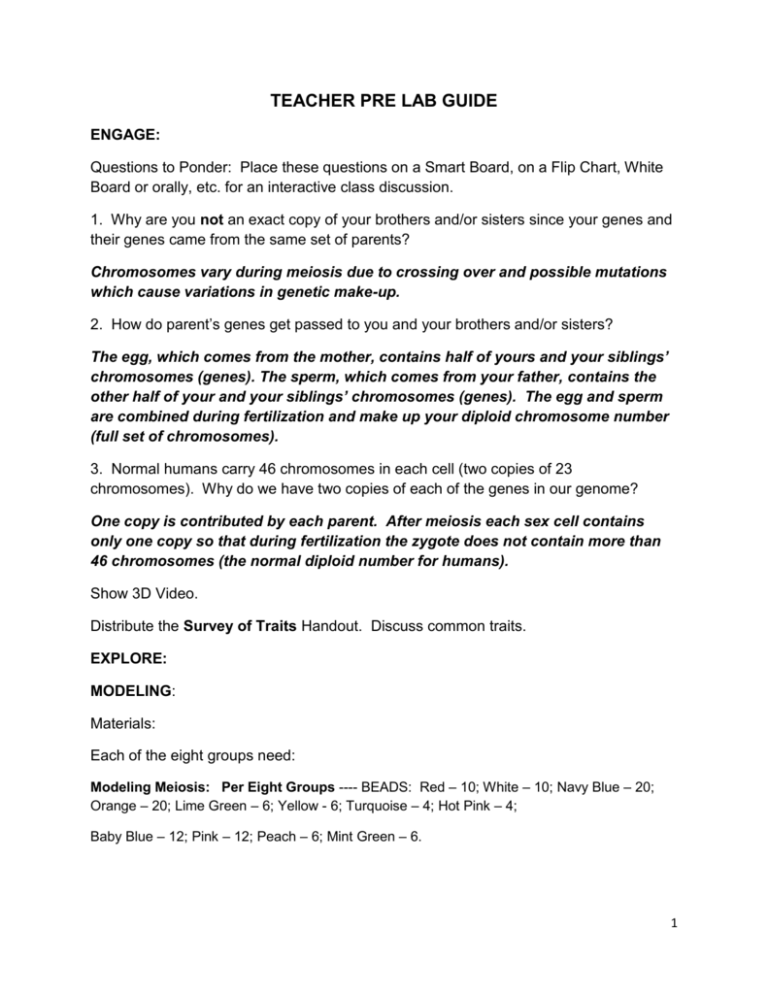
TEACHER PRE LAB GUIDE ENGAGE: Questions to Ponder: Place these questions on a Smart Board, on a Flip Chart, White Board or orally, etc. for an interactive class discussion. 1. Why are you not an exact copy of your brothers and/or sisters since your genes and their genes came from the same set of parents? Chromosomes vary during meiosis due to crossing over and possible mutations which cause variations in genetic make-up. 2. How do parent’s genes get passed to you and your brothers and/or sisters? The egg, which comes from the mother, contains half of yours and your siblings’ chromosomes (genes). The sperm, which comes from your father, contains the other half of your and your siblings’ chromosomes (genes). The egg and sperm are combined during fertilization and make up your diploid chromosome number (full set of chromosomes). 3. Normal humans carry 46 chromosomes in each cell (two copies of 23 chromosomes). Why do we have two copies of each of the genes in our genome? One copy is contributed by each parent. After meiosis each sex cell contains only one copy so that during fertilization the zygote does not contain more than 46 chromosomes (the normal diploid number for humans). Show 3D Video. Distribute the Survey of Traits Handout. Discuss common traits. EXPLORE: MODELING: Materials: Each of the eight groups need: Modeling Meiosis: Per Eight Groups ---- BEADS: Red – 10; White – 10; Navy Blue – 20; Orange – 20; Lime Green – 6; Yellow - 6; Turquoise – 4; Hot Pink – 4; Baby Blue – 12; Pink – 12; Peach – 6; Mint Green – 6. 1 4’x 2’ bulletin board paper, 100 inch piece of black yarn, 60 inch piece of purple yarn, two 32 inch pieces of green yarn, pipe cleaners, scotch tape and scissors. PREPARATION: Set up eight stations with the materials listed above. PROCEDURE: Hand out Student Lab Guide I to each group. Modeling Gamete Formation: Per Eight Groups ---- 2 colors of Play Dough in a zip lock bag, four 2” pieces of red yarn. PREPARATION: Set up eight stations with the materials listed above. PROCEDURE: Hand out Student Lab Guide II to each group. Microscope Observation of Meiosis: Per Eight Groups ---- Microscopes, prepared slides of meiosis of the lily anther and lily ovulary. PREPARATION: Set up microscopes of the lily anther at 40X; set up microscopes of the lily ovulary at 40X. PROCEDURE: Hand out the Student Lab Guide: Meiotic Observation ANSWERS TO QUESTION: STUDENT LAB GUIDE 1 INTRODUCTION and BACKGROUND (Page 2) 1. The two sets come from the parents. The father provides the sperm and the mother provides the egg. Either answer is acceptable. 2. a. haploid; c. one complete set of chromosomes. 3. Human gametes have 23 single chromosomes. 4. Fertilization restores the diploid chromosome number. 2 5. Fertilized eggs contain 46 chromosomes or 23 pairs. Either answer is acceptable. 6. Diploid PART B: Page 6 1. Mr. Dibble’s diploid number is: 2 pairs or 4 single chromosomes (either answer is acceptable) 2. Mr. Dibble has green curly fur with blue eyes and pointy ears. PART C: Page 7 1. There are 8 chromatids present in the nucleus. 2. There are 4 chromosomes present. PART E: Page 9 1. No, the movement is completely random. The migration of non-homologous pairs of chromosomes is completely independent and does not influence the migration of other pairs of non-homologous chromosomes. Therefore, the side of the nucleus that any non-homologous pair migrates toward does not influence the migration of any other non-homologous pair. PART G: Page 10 1. No, they contain different combinations of genes on their chromosomes. When crossing over occurs, pieces of chromosomes that contain different genes (alleles) move to opposite homologous chromosomes, replacing the original parts; therefore, the homologous pairs no longer contain the same genetic material as the original chromosomes in the parent cell. PART J: Page 13 1. The cells produced in Telophase II are haploid. 2. No. Crossing over occurred between both pairs of homologous chromosomes which gave each daughter cell new combinations of genetic material. 3. Write the genotype of the following: Daughter Cell A: BBPPggCC Daughter Cell B: BBppggcc Daughter Cell C: bbPPGGCC 3 Daughter Cell D: bbppGGcc 4. What eye color would: Daughter Cell A contribute: Blue Daughter Cell B contribute: Blue Daughter Cell C contribute: Pink Daughter Cell D contribute: Pink 5. What ear shape would: Daughter Cell A contribute: Pointy Daughter Cell B contribute: Flat Daughter Cell C contribute: Pointy Daughter Cell D contribute: Flat 6. What fur color would: Daughter Cell A contribute: Yellow Daughter Cell B contribute: Yellow Daughter Cell C contribute: Lime Green Daughter Cell D contribute: Lime Green 7. What fur texture would : Daughter Cell A contribute: Curly Daughter Cell B contribute: Straight Daughter Cell C contribute: Curly Daughter Cell D contribute: Straight ANSWERS TO QUESTIONS TO STUDENT LAB GUIDE II Page 5 1. Answers may vary. 2. Too many chromosomes lead to fatal mutations. 4 ANSWERS TO QUESTIONS IN MISCUES IN MEIOSIS HANDOUT Part A: Page 2 1. 47, XX, +21 2. C Part B: Page 3 1. 47, XXY 2. B Part C: Page 4 1. 47, XY, +13 2. D Prepared by: Dr. Debbie Payne, Ruth H. Liddell, Shirley K. Scarbrough Alabama State University, Math, Science Partnership, Spring 2013 5
